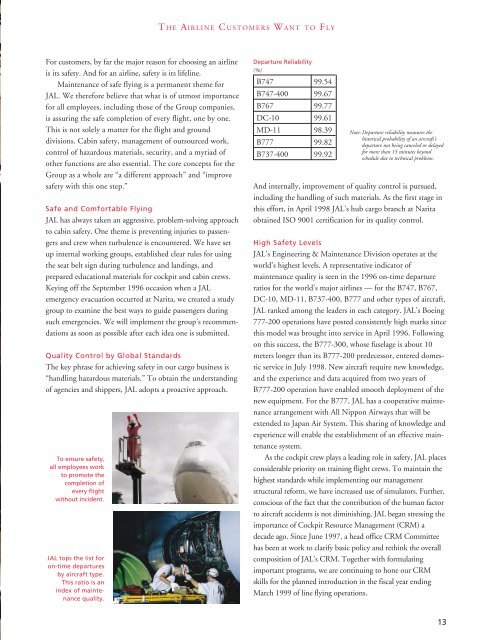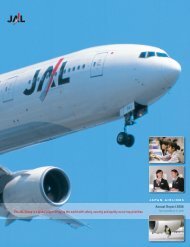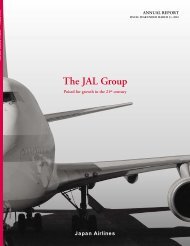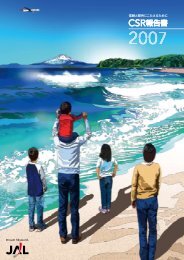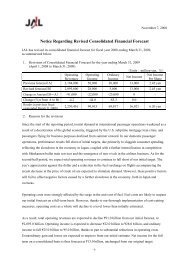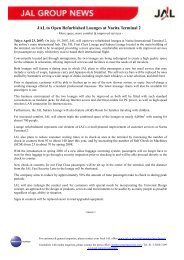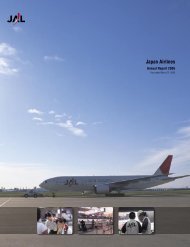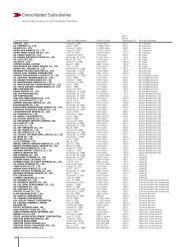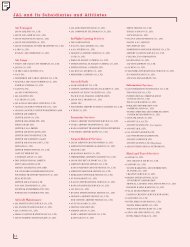JAL pdf - JAL | JAPAN AIRLINES
JAL pdf - JAL | JAPAN AIRLINES
JAL pdf - JAL | JAPAN AIRLINES
- No tags were found...
Create successful ePaper yourself
Turn your PDF publications into a flip-book with our unique Google optimized e-Paper software.
T HE AIRLINE CUSTOMERS WANT TO FLYFor customers, by far the major reason for choosing an airlineis its safety. And for an airline, safety is its lifeline.Maintenance of safe flying is a permanent theme for<strong>JAL</strong>. We therefore believe that what is of utmost importancefor all employees, including those of the Group companies,is assuring the safe completion of every flight, one by one.This is not solely a matter for the flight and grounddivisions. Cabin safety, management of outsourced work,control of hazardous materials, security, and a myriad ofother functions are also essential. The core concepts for theGroup as a whole are “a different approach” and “improvesafety with this one step.”Safe and Comfortable Flying<strong>JAL</strong> has always taken an aggressive, problem-solving approachto cabin safety. One theme is preventing injuries to passengersand crew when turbulence is encountered. We have setup internal working groups, established clear rules for usingthe seat belt sign during turbulence and landings, andprepared educational materials for cockpit and cabin crews.Keying off the September 1996 occasion when a <strong>JAL</strong>emergency evacuation occurred at Narita, we created a studygroup to examine the best ways to guide passengers duringsuch emergencies. We will implement the group’s recommendationsas soon as possible after each idea one is submitted.Quality Control by Global StandardsThe key phrase for achieving safety in our cargo business is“handling hazardous materials.” To obtain the understandingof agencies and shippers, <strong>JAL</strong> adopts a proactive approach.To ensure safety,all employees workto promote thecompletion ofevery flightwithout incident.<strong>JAL</strong> tops the list foron-time departuresby aircraft type.This ratio is anindex of maintenancequality.Departure Reliability(%)B747 99.54B747-400 99.67B767 99.77DC-10 99.61MD-11 98.39B777 99.82B737-400 99.92Note: Departure reliability measures thehistorical probability of an aircraft’sdeparture not being canceled or delayedfor more than 15 minutes beyondschedule due to technical problems.And internally, improvement of quality control is pursued,including the handling of such materials. As the first stage inthis effort, in April 1998 <strong>JAL</strong>’s hub cargo branch at Naritaobtained ISO 9001 certification for its quality control.High Safety Levels<strong>JAL</strong>’s Engineering & Maintenance Division operates at theworld’s highest levels. A representative indicator ofmaintenance quality is seen in the 1996 on-time departureratios for the world’s major airlines — for the B747, B767,DC-10, MD-11, B737-400, B777 and other types of aircraft,<strong>JAL</strong> ranked among the leaders in each category. <strong>JAL</strong>’s Boeing777-200 operations have posted consistently high marks sincethis model was brought into service in April 1996. Followingon this success, the B777-300, whose fuselage is about 10meters longer than its B777-200 predecessor, entered domesticservice in July 1998. New aircraft require new knowledge,and the experience and data acquired from two years ofB777-200 operation have enabled smooth deployment of thenew equipment. For the B777, <strong>JAL</strong> has a cooperative maintenancearrangement with All Nippon Airways that will beextended to Japan Air System. This sharing of knowledge andexperience will enable the establishment of an effective maintenancesystem.As the cockpit crew plays a leading role in safety, <strong>JAL</strong> placesconsiderable priority on training flight crews. To maintain thehighest standards while implementing our managementstructural reform, we have increased use of simulators. Further,conscious of the fact that the contribution of the human factorto aircraft accidents is not diminishing, <strong>JAL</strong> began stressing theimportance of Cockpit Resource Management (CRM) adecade ago. Since June 1997, a head office CRM Committeehas been at work to clarify basic policy and rethink the overallcomposition of <strong>JAL</strong>’s CRM. Together with formulatingimportant programs, we are continuing to hone our CRMskills for the planned introduction in the fiscal year endingMarch 1999 of line flying operations.13


